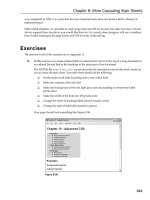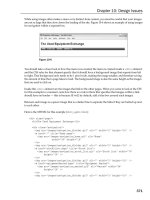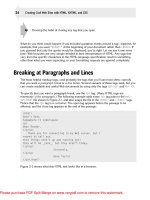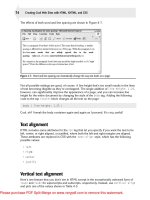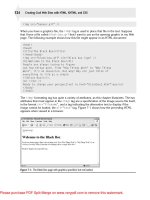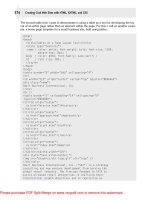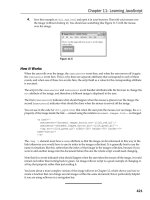wrox beginning web programming with html xhtml and css 2nd edition apr 2008
Bạn đang xem bản rút gọn của tài liệu. Xem và tải ngay bản đầy đủ của tài liệu tại đây (12.16 MB, 770 trang )
Beginning
Web Programming with
HTML, XHTML, and CSS
Second Edition
Jon Duckett
59313ffirs.qxd:WroxPro 3/22/08 2:30 PM Page v
59313ffirs.qxd:WroxPro 3/22/08 2:30 PM Page iv
Beginning Web Programming with
HTML, XHTML, and CSS
Introduction . . . . . . . . . . . . . . . . . . . . . . . . . . . . . . . . . . . . . . . . . . . . . . . xxiii
Chapter 1: Creating Structured Documents . . . . . . . . . . . . . . . . . . . . . . . . . . 1
Chapter 2: Links and Navigation. . . . . . . . . . . . . . . . . . . . . . . . . . . . . . . . . . 53
Chapter 3: Images and Objects . . . . . . . . . . . . . . . . . . . . . . . . . . . . . . . . . . 77
Chapter 4: Tables . . . . . . . . . . . . . . . . . . . . . . . . . . . . . . . . . . . . . . . . . . . 109
Chapter 5: Forms. . . . . . . . . . . . . . . . . . . . . . . . . . . . . . . . . . . . . . . . . . . . 139
Chapter 6: Frames . . . . . . . . . . . . . . . . . . . . . . . . . . . . . . . . . . . . . . . . . . . 185
Chapter 7: Cascading Style Sheets . . . . . . . . . . . . . . . . . . . . . . . . . . . . . . 211
Chapter 8: More Cascading Style Sheets . . . . . . . . . . . . . . . . . . . . . . . . . . 273
Chapter 9: Page Layout . . . . . . . . . . . . . . . . . . . . . . . . . . . . . . . . . . . . . . . 323
Chapter 10: Design Issues . . . . . . . . . . . . . . . . . . . . . . . . . . . . . . . . . . . . . 361
Chapter 11: Learning JavaScript. . . . . . . . . . . . . . . . . . . . . . . . . . . . . . . . . 403
Chapter 12: Working with JavaScript . . . . . . . . . . . . . . . . . . . . . . . . . . . . . 453
Chapter 13: Putting Your Site on the Web . . . . . . . . . . . . . . . . . . . . . . . . . 501
Appendix A: Answers to Exercises . . . . . . . . . . . . . . . . . . . . . . . . . . . . . . . 539
Appendix B: XHTML Element Reference . . . . . . . . . . . . . . . . . . . . . . . . . . . 563
Appendix C: CSS Properties. . . . . . . . . . . . . . . . . . . . . . . . . . . . . . . . . . . . 607
Appendix D: Color Names and Values . . . . . . . . . . . . . . . . . . . . . . . . . . . . . 637
Appendix E: Character Encodings. . . . . . . . . . . . . . . . . . . . . . . . . . . . . . . . 645
Appendix F: Special Characters . . . . . . . . . . . . . . . . . . . . . . . . . . . . . . . . . 649
Appendix G: Language Codes . . . . . . . . . . . . . . . . . . . . . . . . . . . . . . . . . . . 665
Appendix H: MIME Media Types . . . . . . . . . . . . . . . . . . . . . . . . . . . . . . . . . 669
Appendix I: Deprecated and Browser-Specific Markup . . . . . . . . . . . . . . . . . 681
Index . . . . . . . . . . . . . . . . . . . . . . . . . . . . . . . . . . . . . . . . . . . . . . . . . . . . 715
59313ffirs.qxd:WroxPro 3/22/08 2:30 PM Page i
59313ffirs.qxd:WroxPro 3/22/08 2:30 PM Page ii
Beginning
Web Programming with
HTML, XHTML, and CSS
Second Edition
59313ffirs.qxd:WroxPro 3/22/08 2:30 PM Page iii
59313ffirs.qxd:WroxPro 3/22/08 2:30 PM Page iv
Beginning
Web Programming with
HTML, XHTML, and CSS
Second Edition
Jon Duckett
59313ffirs.qxd:WroxPro 3/22/08 2:30 PM Page v
From library of Wow! eBook
www.wowebook.com
Beginning Web Programming
with HTML, XHTML, and CSS, Second Edition
Published by
Wiley Publishing, Inc.
10475 Crosspoint Boulevard
Indianapolis, IN 46256
www.wiley.com
Copyright © 2008 by Wiley Publishing, Inc., Indianapolis, Indiana
ISBN: 978-0-470-25931-3
Manufactured in the United States of America
10 9 8 7 6 5 4 3 2 1
No part of this publication may be reproduced, stored in a retrieval system or transmitted in any form or by
any means, electronic, mechanical, photocopying, recording, scanning or otherwise, except as permitted
under Sections 107 or 108 of the 1976 United States Copyright Act, without either the prior written permission
of the Publisher, or authorization through payment of the appropriate per-copy fee to the Copyright Clearance
Center, 222 Rosewood Drive, Danvers, MA 01923, (978) 750-8400, fax (978) 646-8600. Requests to the Publisher
for permission should be addressed to the Legal Department, Wiley Publishing, Inc., 10475 Crosspoint Blvd.,
Indianapolis, IN 46256, (317) 572-3447, fax (317) 572-4355, or online at
/>/permissions
.
Limit of Liability/Disclaimer of Warranty: The publisher and the author make no representations or war-
ranties with respect to the accuracy or completeness of the contents of this work and specifically disclaim all
warranties, including without limitation warranties of fitness for a particular purpose. No warranty may be
created or extended by sales or promotional materials. The advice and strategies contained herein may not
be suitable for every situation. This work is sold with the understanding that the publisher is not engaged in
rendering legal, accounting, or other professional services. If professional assistance is required, the services
of a competent professional person should be sought. Neither the publisher nor the author shall be liable for
damages arising herefrom. The fact that an organization or Website is referred to in this work as a citation
and/or a potential source of further information does not mean that the author or the publisher endorses the
information the organization or Website may provide or recommendations it may make. Further, readers
should be aware that Internet Websites listed in this work may have changed or disappeared between when
this work was written and when it is read.
For general information on our other products and services or to obtain technical support, please contact
our Customer Care Department within the U.S. at (800) 762-2974, outside the U.S. at (317) 572-3993 or fax
(317) 572-4002.
Library of Congress Cataloging-in-Publication Data is available from the publisher.
Trademarks: Wiley, the Wiley logo, Wrox, the Wrox logo, Wrox Programmer to Programmer, and related
trade dress are trademarks or registered trademarks of John Wiley & Sons, Inc. and/or its affiliates, in the
United States and other countries, and may not be used without written permission. All other trademarks
are the property of their respective owners. Wiley Publishing, Inc. is not associated with any product or
vendor mentioned in this book.
Wiley also publishes its books in a variety of electronic formats. Some content that appears in print may not
be available in electronic books.
59313ffirs.qxd:WroxPro 3/22/08 2:30 PM Page vi
About the Author
Jon Duckett published his first web site in 1996 while studying for a BSc (Hons) in Psychology at Brunel
University, London. Since then, he has helped create a wide variety of web sites for companies of all
sizes. He has also co-written more than ten programming-related books on topics from ASP to XML (via
many other letters of the alphabet), covering diverse aspects of web programming including design,
architecture, and coding.
About the Technical Editor
Ben Schupak holds a master’s degree in computer science and has more than nine years of professional
programming experience for large corporations and U.S. federal departments. He lives in the New York
metro area and enjoys traveling.
59313ffirs.qxd:WroxPro 3/22/08 2:30 PM Page vii
59313ffirs.qxd:WroxPro 3/22/08 2:30 PM Page viii
Credits
Acquisitions Editor
Jennifer Watson
Development Editor
William Bridges
Technical Editor
Benjamin Schupak
Production Editor
Christine O’Connor
Copy Editor
Nancy Rapoport
Editorial Manager
Mary Beth Wakefield
Production Manager
Tim Tate
Vice President and Executive Group Publisher
Richard Swadley
Vice President and Executive Publisher
Joseph B. Wikert
Project Coordinator, Cover
Lynsey Stanford
Compositor
Simmy Cover, Happenstance Type-O-Rama
Proofreader
Christopher Jones
Indexer
Johnna VanHoose Dinse
59313ffirs.qxd:WroxPro 3/22/08 2:30 PM Page ix
59313ffirs.qxd:WroxPro 3/22/08 2:30 PM Page x
Contents
Introduction xxiii
Chapter 1: Creating Structured Documents 1
A Web of Structured Documents 1
Introducing XHTML 2
Core Elements and Attributes 9
The <html> Element 9
The <head> Element 10
The <title> Element 11
The <body> Element 11
Attribute Groups 12
Core Attributes 12
Internationalization 14
UI Events 15
Basic Text Formatting 16
White Space and Flow 17
Creating Headings Using hn Elements 18
Creating Paragraphs Using the <p> Element 21
Creating Line Breaks Using the <br /> Element 21
Creating Preformatted Text Using the <pre> Element 22
Presentational Elements 26
The <b> Element 26
The <i> Element 26
The <u> Element (deprecated) 27
The <s> and <strike> Elements (deprecated) 27
The <tt> Element 27
The <sup> Element 28
The <sub> Element 28
The <big> Element 28
The <small> Element 28
The <hr /> Element 28
Phrase Elements 29
The <em> Element Adds Emphasis 30
The <strong> Element Adds Strong Emphasis 30
The <abbr> Element Is for Abbreviations 31
59313ftoc.qxd:WroxPro 3/22/08 2:31 PM Page xi
xii
Contents
The <acronym> Element Is for Acronym Use 31
The <dfn> Element Is for Special Terms 32
The <blockquote> Element Is for Quoting Text 32
The <q> Element Is for Short Quotations 33
The <cite> Element Is for Citations 33
The <code> Element Is for Code 34
The <kbd> Element Is for Text Typed on a Keyboard 34
The <var> Element Is for Programming Variables 35
The <samp> Element Is for a Program Output 35
The <address> Element Is for Addresses 36
Lists 36
Using the <ul> Element to Create Unordered Lists 36
Ordered Lists 37
Definition Lists 39
Nesting Lists 40
How It Works 43
Editing Text 45
Using <ins> to Indicate New Additions to Text 46
Using <del> to Indicate Deleted Text 46
Using Character Entities for Special Characters 47
Comments 47
The <font> Element (deprecated) 48
Understanding Block and Inline Elements 48
Grouping Elements with <div> and <span> 49
Summary 50
Exercises 51
Chapter 2: Links and Navigation 53
Basic Links 54
Linking to Other Documents 54
Linking to E-mail Addresses 56
Understanding Directories and Directory Structures 57
What Are You Linking To? 58
What a URL Is Made Up Of 59
Absolute and Relative URLs 61
The <base> Element 64
Creating Links with the <a> Element 65
Creating a Source Anchor with the href Attribute 65
Creating a Destination Anchor Using the name and id Attributes
(linking to a specific part of a page) 66
59313ftoc.qxd:WroxPro 3/22/08 2:31 PM Page xii
xiii
Contents
Advanced E-mail Links 74
Summary 75
Exercises 76
Chapter 3: Images and Objects 77
Adding Images to Your Site 77
Types of Image Formats 78
Bitmap Images 78
Vector Images 85
Adding Images Using the <img> Element 86
Adding Other Objects with the <object> Element 93
The <object> Element’s Attributes 94
The <param> Element 97
Adding a Flash Movie To A Page 98
Using Images as Links 99
Image Maps 100
Server-Side Image Maps 101
Client-Side Image Maps 102
Summary 105
Exercises 106
Chapter 4: Tables 109
Introducing Tables 109
Basic Table Elements and Attributes 112
The <table> Element Creates a Table 113
The <tr> Element Contains Table Rows 117
The <td> and <th> Elements Represent Table Cells 119
Advanced Tables 125
Splitting Up Tables Using a Head, Body, and Foot 125
Adding a <caption> to a Table 128
Spanning Columns Using the colspan Attribute 128
Spanning Rows Using the rowspan Attribute 129
Grouping Columns Using the <colgroup> Element 130
Columns Sharing Styles Using the <col> Element 132
Accessibility Issues with Tables 132
How Tables Linearize 132
Linearization of Tables Used for Layout 133
Linearization of Tables Used for Data 135
Summary 136
Exercises 136
59313ftoc.qxd:WroxPro 3/22/08 2:31 PM Page xiii
xiv
Contents
Chapter 5: Forms 139
Introducing Forms 140
Creating a Form with the <form> Element 141
The action Attribute 142
The method Attribute 142
The id Attribute 142
The name Attribute (deprecated) 142
The onsubmit Attribute 143
The onreset Attribute 143
The enctype Attribute 144
The accept-charset Attribute 144
The accept Attribute 144
The target Attribute 145
White Space and the <form> Element 145
Form Controls 145
Text Inputs 145
Buttons 150
Checkboxes 154
Radio Buttons 156
Select Boxes 158
File Select Boxes 164
Hidden Controls 165
Object Controls 166
Creating Labels for Controls and the <label> Element 169
Structuring Your Forms with <fieldset> and <legend> Elements 171
Focus 173
Tabbing Order 173
Access Keys 175
Disabled and Read-Only Controls 176
Sending Form Data to the Server 178
HTTP get 178
HTTP post 179
Summary 183
Exercises 183
Chapter 6: Frames 185
Introducing the Frameset 185
When to Use Frames 188
The <frameset> Element 189
The cols Attribute 189
The rows Attribute 191
59313ftoc.qxd:WroxPro 3/22/08 2:31 PM Page xiv
xv
Contents
Browser-Specific Extensions to the <frameset> Element 192
The <frame> Element 194
The src Attribute 195
The name Attribute 195
The frameborder Attribute 195
The marginwidth and marginheight Attributes 196
The noresize Attribute 196
The scrolling Attribute 196
The longdesc Attribute 197
The <noframes> Element 197
Creating Links Between Frames 198
Setting a Default Target Frame Using the <base> Element 200
Nested Framesets 200
Floating or Inline Frames with <iframe> 204
The <iframe> Element 206
Summary 209
Exercises 209
Chapter 7: Cascading Style Sheets 211
Introducing CSS 212
A Basic Example 213
Inheritance 216
Where You Can Add CSS Rules 217
The <link> Element 218
The <style> Element 220
Advantages of External CSS Style Sheets 220
CSS Properties 221
Controlling Fonts 223
The font-family Property 224
The font-size Property 226
The font-weight Property 227
The font-style Property 228
The font-variant Property 229
The font-stretch Property 230
The font-size-adjust Property 230
Text Formatting 230
The color Property 231
The text-align Property 231
The vertical-align Property 232
The text-decoration Property 234
The text-indent Property 234
The text-shadow Property 235
59313ftoc.qxd:WroxPro 3/22/08 2:31 PM Page xv
xvi
Contents
The text-transform Property 235
The letter-spacing Property 236
The word-spacing Property 237
The white-space Property 237
The direction Property 238
The unicode-bidi Property 239
Text Pseudo-Classes 239
The first-letter Pseudo-Class 239
The first-line Pseudo-Class 240
Selectors 243
Universal Selector 243
The Type Selector 243
The Class Selector 244
The ID Selector 244
The Child Selector 244
The Descendent Selector 245
The Adjacent Sibling Selector 245
Using Child and Adjacent Sibling Selectors to Reduce Dependence
on Classes in Markup 245
Attribute Selectors 247
Lengths 249
Absolute Units 249
Relative Units 249
Percentages 251
Introducing the Box Model 251
An Example Illustrating the Box Model 252
The Border Properties 255
The padding Property 258
The margin Property 259
Dimensions 260
Summary 270
Exercises 270
Chapter 8: More Cascading Style Sheets 273
Links 274
Backgrounds 275
The background-color Property 276
The background-image Property 277
The background-repeat Property 278
The background-position Property (for fixing position of backgrounds) 281
The background-attachment Property (for watermarks) 282
The background Property (the well-supported shorthand) 283
59313ftoc.qxd:WroxPro 3/22/08 2:31 PM Page xvi
xvii
Contents
Lists 283
The list-style-type Property 284
The list-style-position Property 285
The list-style-image Property 286
The list-style Property (the shorthand) 286
The marker-offset Property 287
Tables 287
Table-Specific Properties 289
The border-collapse Property 289
The border-spacing Property 291
The caption-side Property 292
The empty-cells Property 292
The table-layout Property 294
Outlines 294
The outline-width Property 295
The outline-style Property 295
The outline-color Property 295
The outline Property (the shorthand) 296
The :focus and :active Pseudo-Classes 296
Generated Content 297
The :before and :after Pseudo-Elements 297
The content Property 298
Miscellaneous Properties 301
The cursor Property 301
The display Property 302
The visibility Property 302
Additional Rules 304
The @import Rule: Modularized Style Sheets 304
The @charset Rule 305
The !important Rule 305
Positioning with CSS 305
Normal Flow 306
The position Property 306
Box Offset Properties 307
Relative Positioning 307
Absolute Positioning 309
Fixed Positioning 310
The z-index Property 311
Floating Using the float Property 312
The clear Property 314
Summary 320
Exercises 321
59313ftoc.qxd:WroxPro 3/22/08 2:31 PM Page xvii
xviii
Contents
Chapter 9: Page Layout 323
Understanding the Site 323
Understanding a Site’s Aims 324
Whom You Expect to Visit 325
New Content 326
Defining Your Site’s Content 326
Grouping and Categorization 327
Creating a Site Map 328
Identifying Key Elements for Every Page 329
Page Size (and Screen Resolution) 330
Fixed-Width vs. Liquid Designs 331
Designing Pages 337
Sketching the Placement of Elements 337
Introducing the Style 339
Navigation 342
Home Pages 345
Content Pages 345
Structuring Pages 346
Single-Column Layouts 348
Two-Column Layouts 350
Three-Column Layouts 353
Sacrificial Columns 354
Advanced Layout Using CSS 356
Creating a Layout Using Nested Tables 356
Summary 359
Exercises 359
Chapter 10: Design Issues 361
Text 362
White Space Helps Make More Attractive Pages 362
Carefully Aligned Text Is More Readable 365
Adjusting Line Height Makes Text More Readable 365
Wide Columns of Text Are Harder to Read 366
Background Images Can Make Text Hard to Read 366
Choose Fonts Carefully 367
Fixed-Size Fonts Are Affected by Screen Resolution 369
Navigation 369
Menus 369
Links 374
Site Search Features 375
59313ftoc.qxd:WroxPro 3/22/08 2:31 PM Page xviii
xix
Contents
Shading Multiple Rows of a Table 378
Forms 380
Before Designing the Form 380
Designing the Form 382
Summary 401
Exercises 401
Chapter 11: Learning JavaScript 403
What Is Programming About? 404
How to Add a Script to Your Pages 406
Comments in JavaScript 408
The <noscript> Element 408
The Document Object Model 410
Introducing the Document Object Model 410
Objects, Methods, and Properties 412
The Forms Collection 415
Form Elements 416
Images Collection 419
Different Types of Objects 422
Starting to Program with JavaScript 422
Variables 423
Assigning a Value to a Variable 424
Lifetime of a Variable 424
Operators 424
Arithmetic Operators 425
Assignment Operators 425
Comparison Operators 426
Logical or Boolean Operators 427
String Operator 427
Functions 427
How to Define a Function 428
How to Call a Function 428
The Return Statement 429
Conditional Statements 429
if Statements 429
if . . . else Statements 430
A switch Statement 431
Conditional (or Ternary) Operator 432
Looping 432
while 433
do . . . while 434
59313ftoc.qxd:WroxPro 3/22/08 2:31 PM Page xix
xx
Contents
for 434
Infinite Loops and the break Statement 435
Events 435
Built-in Objects 437
String 437
Date 441
Math 444
Array 446
Window 447
Writing JavaScript 449
A Word About Data Types 450
Keywords 451
Summary 451
Exercises 452
Chapter 12: Working with JavaScript 453
Practical Tips for Writing Scripts 453
Has Someone Already Written This Script? 454
Reusable Functions 454
Using External JavaScript Files 455
Place Scripts in a Scripts Folder 455
Form Validation 456
When to Validate 456
How to Validate 456
Form Enhancements 470
Focus on First Form Item 470
Auto-Tabbing Between Fields 471
Disabling a Text Input 472
Case Conversion 474
Trimming Spaces from Beginning and End of Fields 474
Selecting All the Content of a Text Area 475
Check and Uncheck All Checkboxes 476
Image Rollovers 482
Random Script Generator 485
Pop-Up Windows 486
JavaScript Libraries 487
Animated Effects using Scriptaculous 488
Drag-and-Drop Sortable Lists Using Scriptaculous 490
Sortable Tables with MochiKit 492
Creating Calendars with YUI 494
Auto-Completing Text Inputs with YUI 495
59313ftoc.qxd:WroxPro 3/22/08 2:31 PM Page xx
xxi
Contents
When Not to Use JavaScript 496
Drop-Down Navigation Menus 497
Hiding Your E-mail Address 497
Quick Jump Select Boxes 497
Anything the User Requires from Your Site 497
Summary 498
Exercises 498
Chapter 13: Putting Your Site on the Web 501
Meta Tags 502
name and content Attributes 503
http-equiv and content 505
The scheme Attribute 508
Testing Your Site 508
The Importance of Directory Structure and Relative URLs 509
Validating HTML, XHTML, and CSS 509
Link Checking 513
Checking Different Screen Resolutions and Color Depths 514
Accessibility Checkers 514
Development Server or Live Server 515
Checking in Different Versions of Browsers 515
Pilot Testing 516
Proofreading 517
Taking the Leap to Live 517
Getting a Domain Name 517
Hosting 518
Search Engine Strategies 522
Other Web Marketing Possibilities 525
Statistical Analysis 526
Version Control 527
What Next? 529
Blogs 529
Discussion Boards or Forums 530
Adding a Search Utility 530
Introducing Other Technologies 531
Server-Side Web Programming: ASP.NET, and PHP 531
Choosing a Server-Side Language 532
Content Management 532
Flash 535
Learning Graphics Packages 536
Summary 537
59313ftoc.qxd:WroxPro 3/22/08 2:31 PM Page xxi
xxii
Contents
Appendix A: Answers to Exercises 539
Appendix B: XHTML Element Reference 563
Appendix C: CSS Properties 607
Appendix D: Color Names and Values 637
Appendix E: Character Encodings 645
Appendix F: Special Characters 649
Appendix G: Language Codes 665
Appendix H: MIME Media Types 669
Appendix I: Deprecated and Browser-Specific Markup 681
Index 715
59313ftoc.qxd:WroxPro 3/22/08 2:31 PM Page xxii
Introduction
There are a lot of books about designing and building web pages, so thank you for picking up this one.
Why do I think it is different? Well, the Web has been around for over a decade now, and during its life
many technologies have been introduced to help you create web pages, some of which have lasted, others
of which have disappeared. Many books that teach you to write web pages are revisions of earlier versions
of the same book and therefore still take the same approach as the previous edition did. The purpose of
this book, however, is to teach you how to create pages for the Web as it is today and will be for the next
few years. Then, once you have worked through this book, it should continue to serve as a helpful refer-
ence text you can keep nearby and dip into when you need to.
At one time, you needed to learn only one language to write web pages: HTML. As the Web has advanced,
however, so have the technologies you need to learn in order to create effective and attractive web pages.
As the title of this book suggests, you will be learning a few different languages:
❑ HTML and XHTML: HTML and XHTML are needed to explain the structure of any web pages.
They’re used to indicate what text should be considered a heading, where paragraphs start and
end, and what images should appear in the document, and to specify links between different
pages. As you might be relieved to hear, you shouldn’t think of HTML and XHTML as two sep-
arate languages. Rather, you can consider XHTML as more like the latest version of HTML.
❑ CSS: CSS is used to control how a document should appear. For example, you can use it to spec-
ify that a typeface should be a large, bold, Arial typeface or that the background of a page should
be a light green. It can also be used to control where different items appear on a page. For example,
you can use CSS to present text in two columns on the same page.
❑ JavaScript: You learn a little bit of JavaScript to add interactivity to the web pages you create, and
to work with the browser displaying the web page.
Despite the fact that you are looking at several languages, not just HTML, you can consider it a very good
time to be coming to the Web because many of the technologies used to create web pages have matured,
and favored methods, or “best practices,” for creating web sites have been emerging. It is these that you
will be learning.
About the Book
As you have already seen, you’ll be learning how to control the structure of a web page with HTML and
XHTML, how to style it with CSS, and how to add interactivity with JavaScript. Just learning about the
latest technologies, however, is not enough to ensure that you can write great web pages. As these tech-
nologies to write web pages have improved, so too have browsers (the programs and devices used to access
the Web). Browsers have reflected — and on occasion even informed — the way the languages used to
create web pages have developed. The problem, as you can probably imagine, is that not everyone has the
latest software installed on his or her computer, and as a result you will not only want to be able to write
59313flast.qxd:WroxPro 3/22/08 2:31 PM Page xxiii

